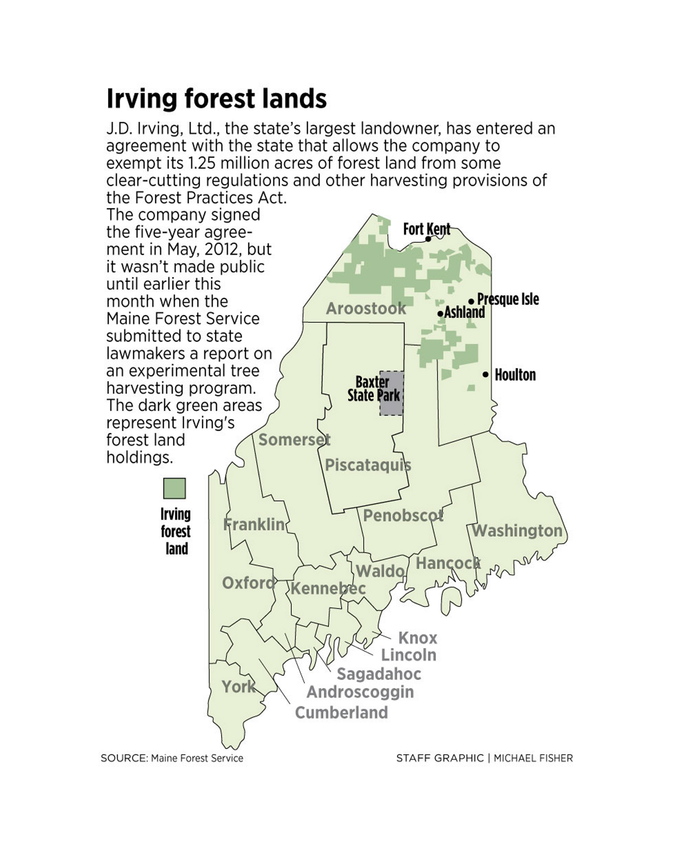State forestry officials have entered into an agreement with J.D. Irving Ltd., Maine’s largest landowner, that allows the company to exempt its 1.25 million acres of forest land from some clear-cutting regulations and other harvesting standards of the Forest Practices Act.
The five-year agreement was signed in May 2012 but wasn’t made public until this month, when the Maine Forest Service gave lawmakers a report on an experimental tree harvesting program known as Outcome Based Forestry.
The program had not drawn any participants since it was established in 2001, but now interest among major timberland owners is on the rise, as word spreads about the deal that allows J.D. Irving to do individual clear-cuts of as much as 250 acres without state approval.
Environmental groups say agreements with major landowners that are largely confidential and push regulatory oversight to a panel appointed by Gov. Paul LePage could endanger the state’s approximately 10 million acres of certified forest land.
Outcome Based Forestry was never intended to be the “bonanza” that the J.D. Irving agreement represents, said Pete Didisheim, advocacy director for the Natural Resources Council of Maine.
“There has been little interest from others before now because I don’t think anybody ever really anticipated that you could get away with this,” he said.
State officials say the agreement with J.D. Irving, and another with the state Bureau of Parks and Lands, will be monitored closely by a panel of experts. They say that there is a scientific rationale for each harvest, and that the aesthetic impact of a cut is reviewed beforehand.
Doug Denico, director of the Maine Forest Service, wrote in a report to the Legislature’s Agriculture, Conservation and Forestry Committee, dated Nov. 13, that there were “intensive” field inspections of harvest sites on J.D. Irving’s land.
Robert Wagner, director of the University of Maine’s School of Forest Resources and Center for Research on Sustainable Forests, is a member of the six-member advisory panel that is overseeing the program. He told the legislative committee Friday that the program will improve forest management practices that have declined since the adoption of the “prescriptive” Forest Practices Act in 1989.
He and other members of the advisory panel said the Outcome Based Forestry program gives landowners more flexibility to effectively manage timberlands, reduce fragmentation between cuts, and increase pest and weed management.
COMPROMISE FOR INDUSTRY
Conservation groups acknowledge the merits of science-based forest management. But critics say the agreement with J.D. Irving defies the original intent of the Outcome Based Forestry program, which was enacted amid a series of debates over clear-cutting that pitted conservationists against the state’s dominant forest products industry.
The program was seen as a compromise for the industry, which had complained that the Forest Practices Act put politics over science and prohibited landowners from doing effective timber harvesting.
The program originally was limited to “experimental” parcels, with no single harvest area exceeding 100,000 acres and a statewide limit of six areas totaling 200,000 acres. Lawmakers lifted the size limits in 2007 and removed a sunset provision in 2011.
J.D. Irving expressed interest in participating in the program after the acreage cap was removed, but it was unable to strike a deal until 2012, when it signed the five-year plan with the LePage administration.
Ked Coffin, a forester employed by Irving, said the program will raise Irving’s softwood harvest by 70 percent over the next 35 years, has helped to increase contractors’ earnings by 21 percent, and is a factor in the company’s plan, announced in August, to build a $30 million sawmill in Ashland.
Irving’s harvest level is not subject to public disclosure because state law treats the information as proprietary.
TIMBER HARVEST INCREASES
According to the Maine Forest Service, the biomass from harvested wood in Maine increased from nearly 485 thousand dry tons in 1995 to nearly 1.2 million dry tons in 2011. In 1995 the sawtimber harvest was 1.3 billion board feet and decreased to 718 million board feet.
Didisheim, with the Natural Resources Council, said Irving stands to benefit financially from the program, which was designed to operate on a much smaller scale. He said that there is little accountability and that the program’s advisory panel is stacked with members of the forest products industry. At least four of the current members have, or have had, involvement with the forest products trade group.
“There’s no accountability for their decision making like there is for state employees to uphold the laws of the state,” Didisheim said. “You’re pushing off into this murky area of a voluntary program and volunteers performing what should be a role of the Maine Forest Service.”
Members of the advisory panel tried to ease concerns when they addressed lawmakers Friday. Many said that landowners still must adhere to provisions of the Forest Practices Act.
Nonetheless, a former member of the panel has expressed concerns.
Bill Patterson, a member of the Nature Conservancy, resigned from the advisory panel in August, writing that the agreement with J.D. Irving and loosened participation requirements were a “significant change in state policy” that warranted public review.
This story has been changed to reflect more accurate timber harvest data.
Steve Mistler can be contacted at 791-6345 or at:
smistler@pressherald.comTwitter: @stevemistler
Send questions/comments to the editors.




Success. Please wait for the page to reload. If the page does not reload within 5 seconds, please refresh the page.
Enter your email and password to access comments.
Hi, to comment on stories you must . This profile is in addition to your subscription and website login.
Already have a commenting profile? .
Invalid username/password.
Please check your email to confirm and complete your registration.
Only subscribers are eligible to post comments. Please subscribe or login first for digital access. Here’s why.
Use the form below to reset your password. When you've submitted your account email, we will send an email with a reset code.